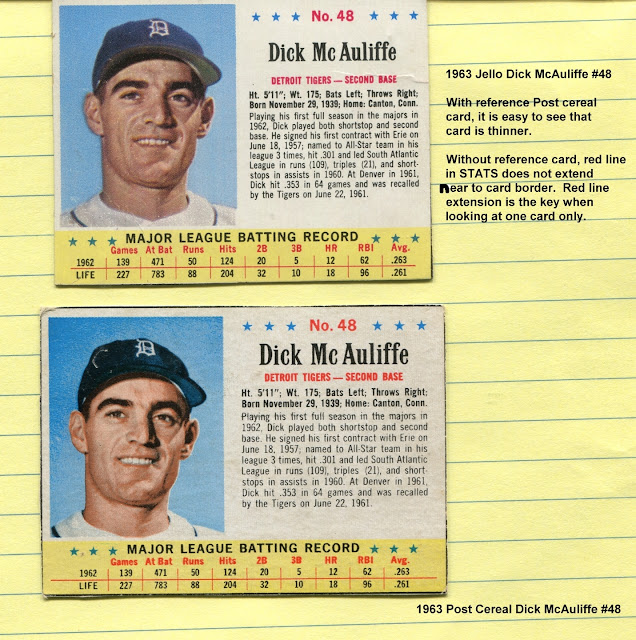For card collectors, identifying a card’s exact issue often becomes a problem when finding vintage cards either at flea markets, card shows or online. To my knowledge, there is not an app yet whereby you can scan a card via your phone and have the issue identified.
The identification issue can become very confusing when several issues look almost exactly alike. For example, Exhibit Supply Company cards of baseball, football and boxing greats had the same basic design over a half of a century with no statistics on the back until the 1960s issues. Therefore, identifying an Exhibit Supply issue requires some knowledge of who was in the issue and sometimes minor differences across the issues in terms of color, printing and other smaller details.
1963 Post Cereal and 1963 Jello
The same problem applies to the 1963 Post Cereal and 1963 Jello baseball sets. Because these cards had the exact same visual design, players and numbers, they are often confused by sellers on eBay and even some experienced collectors who are not familiar with the two card issues.
The main reason for the confusion is that the issuer of the cards in 1963, General Foods, did not intend for the two issues to be seen as separate from each other. In a clever marketing cross-promotion, both boxes of Jello and boxes of Post Cereal had one-sided baseball cards printed on the back of the box. These cards could be pasted into a single album that General Foods gave away as a promotion in 1963 in which you could paste cards from either Jello or Post Cereal. Hence, if a parent was buying either jello or cereal, you could get them to look for specific players. Hence, it would be easier to fill your album with two product lines issuing the same cards.
In general, it was easier to complete your collection through cereal boxes because the cards were issued in panels of multiple cards on the back of the boxes (complete 1963 box panels are collected today and sometimes sold on eBay). Jello boxes were so small that only a single card could be placed on the back of the boxes. However, because of the need to fit one card onto the back of a Jello box, the 1963 Jello cards were made just a bit smaller than the 1963 Post cards. Also, a small design difference emerged in how the player’s STATS were line-ruled, likely as a result of having to shrink the design.
 |
| Caption: Above is a 1963 Jello box with Sandy Koufax. |
These slight differences have caused hobbyists over the years to see these cards as two sets: 1963 Jello and 1963 Post Cereal. This situation is not what the company likely intended (nor did General Foods managers likely care) when the cards were issued. While some collectors do not care if a card is a Jello or Post card and will buy either issue interchangeably, the vast majority of today’s vintage collectors of these issues are particular about whether a card is Jello card or Post Cereal card.
Indeed, the value of certain cards or players is very dependent on which issue it comes from, either Jello or Post. The scarcity of certain cards and thus their current prices is greatly influenced by their availability in 1963. Players that were on unpopular cereals or jello flavors are scarce today and sell for a premium. Therefore, if you do not identify a card’s issue correctly when selling on eBay or another venue, buyers may be upset. For example, Frank Thomas #197 is a relatively common card in the 1963 Jello set. However, Frank Thomas #197 is one of the hardest cards to find in the 1963 Post Cereal set. Thus, if you list a 1963 Jello Frank Thomas #197 as a 1963 Post Frank Thomas #197, buyers will think you are either ill-informed or trying to scam them. Even worse, you could buy a 1963 Jello Frank Thomas #197 card thinking it is the rare Post version.
Telling the Two Issues Apart
How do you tell the two issues apart? It is easy once you know. Below I have put a scan of both 1963 cards for Dick McAuliffe #48. Jello is on the top. Post is on the bottom. When the cards are side-by-side, it is easy to see that Jello cards are smaller. However, buying online or at a show, one might not have a comparison card. The best way to determine the issue is the red line in the middle of the STATS box. In a 1963 Jello card, the red line stops shortly before and after the player’s STATS. In the 1963 Post card, the red line will extend well beyond the beginning and end of the player’s STATS toward the border (compare McAuliffe cards below).
If one follows the red-line rule (Post = wide red line), you will never confuse cards from the two issues as this design is consistent across all cards.
Conclusion
In closing, please feel free to comment. All comments are moderated to cut down on spam and to stay on the topic.

